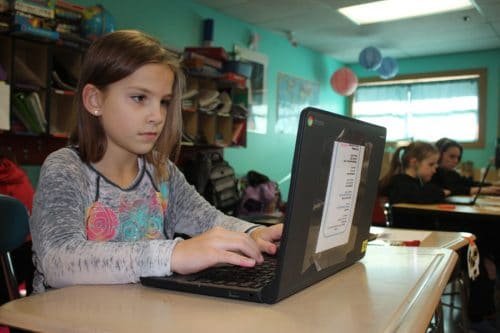 Jordan Givot intently works on a draft of her first novel. Photo: Alice Kinerk, KP News
Jordan Givot intently works on a draft of her first novel. Photo: Alice Kinerk, KP News
Last November, fourth- and fifth-graders in Alice Kinerk’s Minter Creek Elementary School class embarked on a daunting project: writing their own novel in 30 days.
National Novel Writing Month, commonly abbreviated as NaNoWriMo, is an annual event that encourages participants to write a 50,000-word novel in the month of November. Even for seasoned writers, 50,000 words in a single month is difficult; however, the event also has a Young Writers Program that allows students to set their own word-count goals. Many of Kinerk’s students were still aiming for several thousand words by the end of the month.
Before the beginning of the month, Kinerk’s class focused on several pre-writing topics, such as how to structure a story and create interesting characters. This also allowed the students time to develop ideas for their projects: topics in Kinerk’s class ranged from undersea disasters, to fantasy adventures, to a fictionalized account of the Apollo 13 space mission. “If we didn’t plan a bit before in October, I would have spent the first day just thinking about what to write,” said student Riley Oltmann.
Kinerk’s students took on the project happily, with an enthusiasm that surprised even her. “The first day of November, I thought we can try 15 minutes of writing, maybe we can build up to half an hour by the end of the month,” said Kinerk. “I stopped at 15 minutes and they said ‘NO!’ So I went 20 minutes, and every day after it’s been 45 minutes.”
Writing time began with a brief piece of instruction or encouragement, followed by 45 minutes of quiet typing. Some students listened to music while others took short walking breaks or used unrelated writing exercises to stimulate their creativity. After the day’s writing was complete, a few students were chosen to read excerpts from their project, while others and Kinerk offered comments and suggestions. Students could also mark off progress toward their word goals on a poster.
Despite the daunting task before them, midway through November, most students were very positive about the project. “I’ve always thought writing was an amazing thing, and I’ve always wanted to write, but I never had any idea of how to start,” said student Kendall Powers. Several students mentioned that the program had given them a consistent reason to write, and that they had improved just by having to write every day. “I used to hate to write, but now I go home and I want to write more,” said Jordan Givot. “After doing NaNoWriMo, I actually enjoy it. It’s helping me get better at writing.”
NaNoWriMo is promoted and organized by a nonprofit of the same name, which provides the framework for the event and gives students an opportunity to write online. The website’s writing space allows participants to track their progress and make sure they meet their daily goals, with badges and awards for extra advancement. The group also provides resources, worksheets and packets of information for participating classrooms. According to NaNoWriMo’s website, more than 100,000 students per year in classrooms around the world participate in the Young Writers Program.
By the end of the month, most students had emerged with hundreds or thousands of words of creative writing. They all agreed that the project had given them a new perspective on writing. “It really helped; it was just perfect for us,” said Kinerk, who also volunteers as a staff writer for the Key Peninsula News.
UNDERWRITTEN BY THE FUND FOR NONPROFIT NEWS (NEWSMATCH) AT THE MIAMI FOUNDATION, THE ANGEL GUILD, ADVERTISERS, DONORS AND PEOPLE WHO SUPPORT INDEPENDENT, NONPROFIT LOCAL NEWS